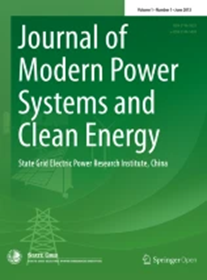Robust Distribution System State Estimation Considering Anomalous Real-Time Measurements and Topology Change
IF 6.1
1区 工程技术
Q1 ENGINEERING, ELECTRICAL & ELECTRONIC
Journal of Modern Power Systems and Clean Energy
Pub Date : 2025-01-23
DOI:10.35833/MPCE.2024.000683
引用次数: 0
Abstract
This paper develops a physics-guided graph network to enhance the robustness of distribution system state estimation (DSSE) against anomalous real-time measurements, as well as a deep auto-encoder (DAE)-based detector and a Gaussian process-aided residual learning (GARL) to deal with challenges arising from topology changes. A global-scanning jumping knowledge network (GSJKN) is first designed to establish the regression rule between the measurement data and state variables. The structural information of distribution system (DS) and a global-scanning module are incorporated to guide the propagation of scarce measurements in the graph topology, contributing to valid estimation precision in sparsely measured DSs. To monitor the topology changes of the network, a DAE network is employed to learn an efficient representation of the measurements of the system under a certain topology, which can achieve online monitoring of the network structure by observing the variation tendency of the reconstruction error. When the topology change occurs, a Gaussian process with a composite kernel is applied to the modeling of the pretrained GSJKN residual to adapt to the new topology. The embedding of the physical structural knowledge enables the proposed GSJKN method to restore the missing/noisy values utilizing the adjacent measurements, which enhances the robustness to typical data acquisition errors. The adopted DAE network and special GARL-based transfer method further allow the DSSE method to rapidly detect and adapt to the topology change, as well as achieve effective quantification of the estimation uncertainties. Comparative tests on balanced and unbalanced systems demonstrate the accuracy, robustness, and adaptability of the proposed DSSE method.考虑异常实时测量和拓扑变化的配电系统鲁棒状态估计
本文开发了一种物理引导图网络来增强配电系统状态估计(DSSE)对异常实时测量的鲁棒性,以及基于深度自编码器(DAE)的检测器和高斯过程辅助残差学习(GARL)来处理拓扑变化带来的挑战。首先设计了全局扫描跳跃知识网络(GSJKN),建立了测量数据与状态变量之间的回归规则。该方法利用配电系统的结构信息和全局扫描模块来指导稀疏测量在图拓扑中的传播,提高了稀疏测量配电系统的估计精度。为了监测网络的拓扑变化,采用DAE网络学习系统在一定拓扑下的测量值的有效表示,通过观察重构误差的变化趋势,实现对网络结构的在线监测。当拓扑发生变化时,采用复合核高斯过程对预训练的GSJKN残差进行建模,以适应新的拓扑结构。物理结构知识的嵌入使GSJKN方法能够利用相邻测量值恢复缺失/噪声值,增强了对典型数据采集误差的鲁棒性。采用DAE网络和特殊的基于garl的传输方法,进一步使DSSE方法能够快速检测和适应拓扑变化,并实现对估计不确定性的有效量化。平衡系统和不平衡系统的对比实验证明了该方法的准确性、鲁棒性和适应性。
本文章由计算机程序翻译,如有差异,请以英文原文为准。
求助全文
约1分钟内获得全文
求助全文
来源期刊

Journal of Modern Power Systems and Clean Energy
ENGINEERING, ELECTRICAL & ELECTRONIC-
CiteScore
12.30
自引率
14.30%
发文量
97
审稿时长
13 weeks
期刊介绍:
Journal of Modern Power Systems and Clean Energy (MPCE), commencing from June, 2013, is a newly established, peer-reviewed and quarterly published journal in English. It is the first international power engineering journal originated in mainland China. MPCE publishes original papers, short letters and review articles in the field of modern power systems with focus on smart grid technology and renewable energy integration, etc.
 求助内容:
求助内容: 应助结果提醒方式:
应助结果提醒方式:


